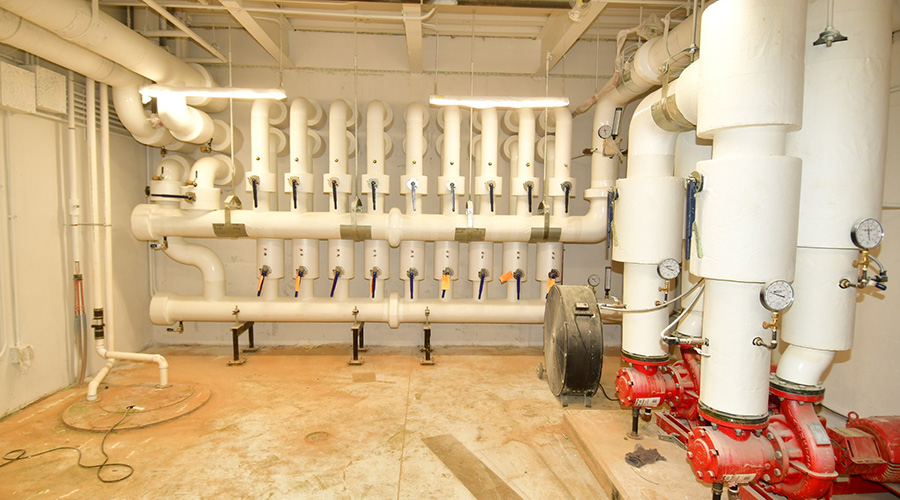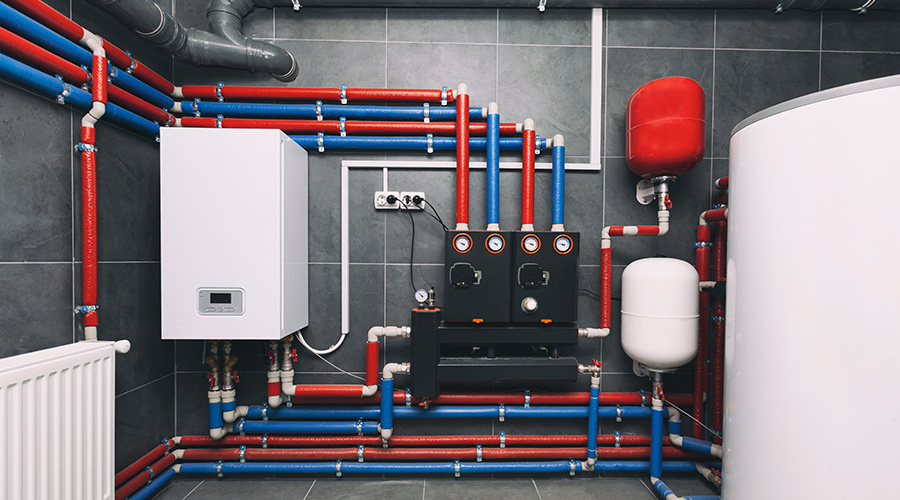Heating Systems: Auditing for Efficiency
Close inspection and testing of key system components — including boilers and control systems — reveal opportunities for improvement
Improving the performance of a building’s heating system is one of the most effective ways of reducing energy costs and operating costs while making the system more reliable. While retrofit programs that focus on replacement of heating system components and systems can achieve the same — and often even greater — benefits, their high implementation costs and corresponding high level of disruption often makes them unsuitable for many institutional facilities.
For maintenance and engineering managers of these facilities, the best option is simply to make certain that the equipment already installed operates properly and at peak efficiency.
Cutting Off Trouble
It is easy to ignore building heating systems. Unless a piece of equipment fails or building occupants complain, most assume that these systems work properly. But just because a system is operating and people are not complaining is no guarantee that it is working efficiently or effectively.
Burners can go out of adjustment, reducing their efficiency. Dirt can clog filters, coils and distribution systems, reducing air-flow rates. Control systems can go out of calibration, causing setpoints to drift away from their optimum setpoints.
In a relatively short period of time, these and other changes taken together can result in a net decrease in operating efficiency of the entire heating system of 10-20 percent. If left uncorrected, the system’s performance will continue to decline, and the risk of system failure will increase.
A Closer Look at Components
A lack of complaints and repair history does not mean the system’s operation cannot or does not need to be improved. Occupants simply might have given up on trying to improve their working conditions. But the system might have significant problems that nobody is aware of. And a slowly developing problem might not have impacted operations yet but will do so sometime soon.
A walk-through audit can identify ongoing problems. For more information on these audits, see sidebar.
A more thorough step is the detailed audit — a component-by-component, systemwide evaluation of all HVAC equipment in the building. The purpose of the detailed audit is to identify specific steps managers can take to make systems and components work more efficiently and effectively. When the audit has been completed, managers will have a detailed listing of everything that can be done to improve the operation of the heating system.
The detailed audit starts with the biggest energy-using systems in the building: the boilers and the distribution system. Any improvements made to these systems will provide the biggest rate of return in terms of both energy savings and HVAC system performance.
For the building’s boilers, the first step is a detailed review of the operating log. Review the log to see if the boiler operates properly and as recommended by the manufacturer. The log also can give clues as to the state of maintenance for the boiler:
-
Are the data entries complete and up to date? While a complete log is no guarantee that the boiler is being well maintained, a partial or incomplete log is a strong indicator that proper attention to boiler maintenance is lacking.
-
When was the boiler last cleaned or treated for scale?
-
How many tubes have been plugged due to leaks or fouling?
-
How effective is the water treatment system? Is it monitored on a regular basis or is it ignored?
-
How often are the boiler’s safety devices tested?
Technicians should open most medium and large boilers once each year for inspection and cleaning. The energy savings achieved by improved operating efficiency from this cleaning usually is sufficient to justify the cost of the process. Since inspection and cleaning must wait until the heating season is over, managers should make plans now to have staff perform the tasks next summer.
The audit also should closely examine the boiler’s control system:
- What type of controls are installed: on-off or modulating control? On-off controls are simple and reliable, but modulating controls more closely match the boiler’s output to the building’s heating requirements, resulting in a significant increase in operating efficiency.
-
Are the boiler’s controls pneumatic, electric or digital?
-
How old are they?
-
When were they last calibrated?
-
If there are multiple boilers serving the building, does the control system allow boilers to be staged to match the increased or decreased heating load?
If the control system is pneumatic or electric and cannot track and match a building’s changing heating load, managers should consider upgrading the entire control system at the end of the current heating season.
Results into Action
Once the audit has been completed on the heating equipment, managers will have a better understanding of the current conditions in their buildings. The next step is to take that information and develop it into an action plan for improving the overall operation of heating systems.
Start by compiling a list of measures to implement that improve operations. Examine each measure on the list to see if several of them can be combined.
For example, if a building is served by one older boiler that is being cycled to track the changing heating load, it might be more cost effective to scrap the entire boiler and replace it with several smaller, modular boilers.
For each measure identified, managers will need to develop a detailed cost estimate. If the measure improves the operating efficiency of the boiler, managers will have to determine the economic impact of the measure and calculate its payback.
If the measure improves system reliability or operating safety, then the managers will have to develop a detailed description of how the operation would be improved. By developing a description of the economic, operational and safety impacts of each of the measures, managers will be better able to understand and, therefore, sell the program to their bosses.
Depending on the type of activity and the availability of properly skilled maintenance personnel, managers might have to contract out a number of the measures for performance by outside firms. Start the process early to ensure that qualified firms will be able to perform the work in a timely manner and according to a schedule that best suits the operations of the building.
Since there most likely will be too many items to complete at the same time, managers must set each measure’s priority. Typical factors to consider when setting an item’s priority include the impact that the measure will have on energy use, safety, operating reliability or maintenance. Managers can implement some measures without having to shut down the boiler. They’ll have to defer other measures until after the end of the heating season.
The walk-through and the detailed audits are not intended to be one-time efforts. Buildings change. Heating requirements change. Equipment wears out, fails, or goes out of calibration.
To keep the heating systems operating at their peak efficiency, both audits should be repeated on a regular basis. Walk-through audits should be performed at least once each year. Detailed audits should be performed every three to five years, more frequently if the building is undergoing a constant and rapid rate of change.
Taking A Stroll Through the System
The first step in improving the performance of heating systems often is a walk-through audit. The purpose of the walk- through audit is to identify the most obvious problems with the heating system. The walk-through audit identifies areas:
-
that are overheated or underheated
-
where temperature control is insufficient or unreliable
-
with an unusually high number of complaints from building occupants
-
in which maintenance personnel have spent an abnormally high amount of time maintaining the system.
Technicians can start the audit process by visiting all areas in the building during the heating season. Note the conditions in the spaces and how closely they match the space requirements.
They also should talk to the building occupants about the conditions they experience throughout the heating system:
-
Are conditions fairly consistent, or do they vary from location to location?
-
Do space conditions vary over time? If so, identify heating systems serving the areas having the most problems.
Next, technicians should review maintenance records for systems and components:
-
Where are complaints most likely to occur?
-
What heating systems require the most maintenance?
-
Are technicians repairing components, or are they implementing quick fixes?
Finally, review the maintenance records for the different systems and components:
-
Where are complaints most likely to occur?
-
What heating systems require the most maintenance attention?
-
Are things really being repaired the right way, or are quick fixes only being implemented?
-
What is the frequency of repeat calls?
By compiling information from building occupants and maintenance records, managers can begin to identify systems that have potential for improvement.
|
Related Topics:











